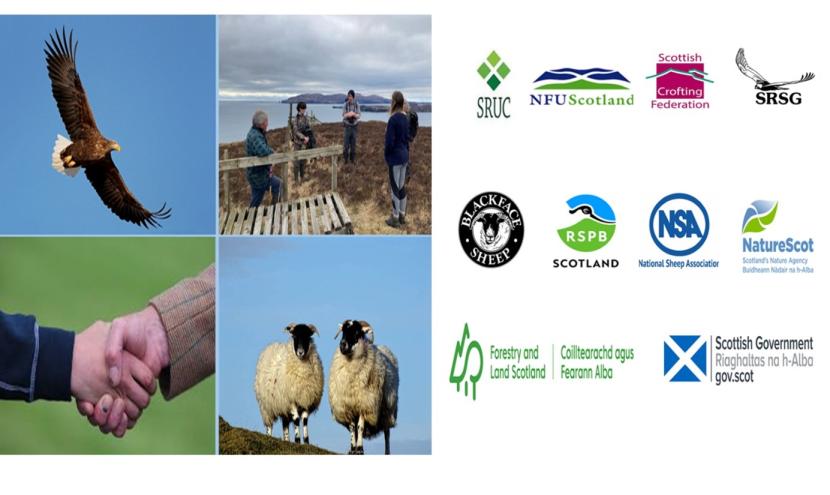Sea Eagle Management Scheme 2024 – Report for Stakeholders
Summary
- In 2024, the Sea Eagle Management Scheme (SEMS) provided support through NatureScot Management Agreements (MAs) to 194 holdings across Scotland.
- These holdings and where relevant, their associated common grazings, extend to over 206,000 hectares with responsibility for over 75,000 breeding ewes.
- The total value of MA support from the SEMS to farmers and crofters in 2024 was £345,515.55
- The majority of holdings received standard measures support from the SEMS, with forty-seven holdings receiving enhanced measures support from the SEMS in 2024.
- Of the forty-seven holdings receiving enhanced measures support, eighteen holdings received support for the enhanced shepherding measure.
- Feedback on enhanced measures support has been collated and accompanies this report.
- Flock performance varied across SEMS holdings in 2024, with average percentage lamb loss in the marking-weaning period of 12.1% and an average weaning percentage of 79.4%.
- SEMS staff and Call off Contractors responded to twenty new Register of Interests in the SEMS and completed a range of fieldwork and site visits in 2024, including prey remains analysis of fourteen sea eagle nests and the installation of nine nest cameras to monitor 2025 breeding attempts and prey selection. A copy of the results from prey remains analysis in 2024 accompanies this report.
- The SEMS was reviewed in 2024 in collaboration with a range of stakeholder representatives. The budgetary position for 2025 is to be confirmed following the passing of the Scottish Budget through the Scottish Parliament.
Introduction
The SEMS provides advice and support to farmers and crofters concerned about, or experiencing livestock predation by white-tailed eagles (WTE) or sea eagles, as they are often known.
It is widely acknowledged that in some places, WTE predate live, healthy lambs and the impact on farmer’s and crofter’s livelihoods can be significant. The issue of livestock loss is complex and the impacts extend beyond the direct loss of individual animals.
NatureScot, through the SEMS, works closely with farmers, crofters, and a range of stakeholder partners to try to mitigate impacts where they occur. NatureScot run the SEMS on behalf of the National Sea Eagle Stakeholder Panel (NSESP), which is comprised of representatives from the following stakeholder organisations:
- NatureScot,
- National Farmers Union of Scotland
- National Sheep Association Scotland
- Scottish Crofting Federation
- Black-faced Sheep Breeders Association
- Royal Society for the Protection of Birds Scotland
- Forestry and Land Scotland
- Scottish Government Rural Payments and Inspections Division
- Scotland's Rural College
- Scottish Raptor Study Group
The SEMS is the main delivery mechanism for the White-Tailed Eagle Action Plan, with both being subject to a review in 2024. The most recent SEMS concluded in December 2024 and the purpose of this report is to provide stakeholders with an overview of the 2024 SEMS.
One of the key areas of discussion during the 2024 SEMS review was in relation to communication and a request to improve communication with stakeholders on the work of the SEMS. We hope the detail of this report is useful to stakeholder partners, SEMS participants and the wider public.
SEMS participation and expenditure
The SEMS provides a range of support to farmers and crofters who are concerned about, or experiencing livestock predation by sea eagles. This includes advice from the NatureScot call off contractor team, loan of scaring equipment, and financial support in the form of Management Agreements (MAs).
The SEMS is focused on mitigation and financial support from NatureScot MAs is not compensatory in nature. This is for several reasons, including MA rules and the complexities of this issue and challenges that adopting compensatory payments that are in place elsewhere in Europe would present. The 2024 SEMS offered support at three different levels:
- Standard measures - Using an area-based calculation to inform payments that range between £500 and £1500 depending on holding size.
- Enhanced measures – Offering support for a range of management, often tailored to an individual holding’s management system which can be combined with standard measures support, up to a maximum of £5000 per annum.
- Capital measures – Offering a percentage contribution towards actual costs of capital projects, depending on MA term. In 2024, this percentage contribution was 45% up to a maximum of £7,500
The submission of a Register of Interest (RoI) is usually the first step for those wishing to participate in the SEMS. The submission of a RoI prompts a visit from one of NatureScot’s call off contractor team. The local call off contractor will discuss the issues being experienced in more detail with the farmer or crofter, better understand the holding’s management system and discuss potential mitigation options and next steps.
In 2024, the call off contractor team or NatureScot SEMS staff visited twenty holdings that submitted new RoIs. Half of the holdings visited in 2024 were in Argyll & Lochaber, which is classed as one area to correspond to reporting for the Argyll & Lochaber Local Sea Eagle Stakeholder Group. A breakdown of the number of holdings visited by area in 2024 is detailed in Figure 1 below:
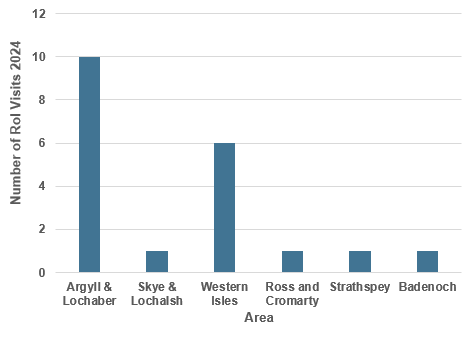
Two hundred and seven MA offers were issued in 2024, with 194 holdings participating in the SEMS. Total MA support to farmers and crofters was £345,515.55, from a total project budget of £400,000. Other expenditure associated with the project include contractor and equipment costs.
Figure 2 below provides an overview of SEMS participation levels and MA support to farmers and crofters in the period 2020-2024.
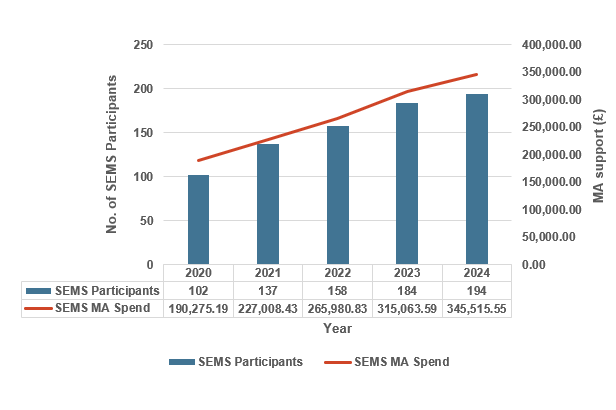
A breakdown of the number of holdings receiving MA support by area in the period 2020-2024 is detailed in Figure 3 below:

Figure 3 highlights that the majority of holdings receiving SEMS MA support are in the Argyll & Lochaber and Skye & Lochalsh areas, with holdings in these areas accounting for 79% of all participating holdings in 2024. Figure 3 also highlights the year-on-year increase in the number of holdings in the Western Isles receiving SEMS MA support in the period 2020-2024.
Enhanced measures support
Enhanced measures support was introduced into the revised SEMS in 2020. Since then, the SEMS has supported a wide range of options under enhanced measures. These options have been aimed at mitigating sea eagle impacts, or assisting with some of the costs associated with management system changes that farmers and crofters have made to mitigate predation impacts.
Enhanced measures MAs were often tailored to individual farm and croft management systems. This required close communication between NatureScot and farmers and crofters, with this support tier providing greater flexibility and support than the solely area-based standard measures approach to the SEMS pre-2020.
Enhanced support was targeted at holdings where sea eagle predation was most acute and holdings that had made significant management changes to mitigate sea eagle predation. In addition, support for enhanced shepherding – a measure launched in 2020 - was included in this support tier and targeted at holdings running extensive hefted hill flocks.
Figure 4 below details the number of holdings receiving enhanced measures support from the SEMS in the period 2020-2024.
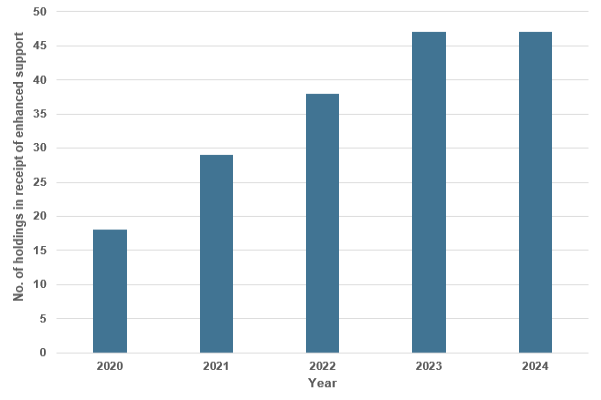
Measures supported at the forty-seven holdings in receipt of enhanced MA support in 2024 included contributions towards costs associated with indoor or in-bye lambing, in-bye retention of ewes and lambs, liming of in-bye and away-wintering of ewes, as well as the previously mentioned enhanced shepherding measure, with eighteen holdings delivering enhanced shepherding across Argyll, Skye & Lochalsh, Wester Ross, Sutherland and the Isle of Lewis.
The spreadsheet associated with this report details anonymised feedback from those receiving support for the enhanced shepherding measure in the period 2020-2024, in addition to feedback from those receiving support for other enhanced measures in 2024.
Feedback from farmers and crofters on these measures was collected during the completion of annual reporting forms associated with the Scheme. This feedback alongside the feedback from stakeholder representatives during the SEMS Review in 2024 will form an important part of considerations on the development of the SEMS going forward.
Call off contractor and observer fieldwork
The SEMS call off contractor team are contracted on an annual basis by NatureScot to liaise with farmers and crofters who have concerns about or are experiencing sea eagle predation issues at their holding. The call off contractor team are all experts in sea eagle ecology but also have an understanding of farming and crofting, with some of this team having kept livestock of their own or been employed in the agricultural sector in the past.
In 2024, the SEMS had a core team of six call off contractors. This team and some of the fieldwork that they deliver, is supported by two NatureScot staff members and in 2024, two observers who delivered observations at two farms in Argyll.
In 2024, the call off contractor team visited several farms and crofts participating in the SEMS to discuss ongoing issues, carry out monitoring work and advise on the SEMS. Twenty new holdings were also visited in response to submissions of RoIs in the SEMS for 2025.
In 2024, members of the call off contractor team collected prey remains for analysis from fourteen sea eagle nests across Scotland. The sea eagle nests visited were on or near holdings participating in the SEMS, or on or near holdings that had raised concerns about sea eagle predation of livestock.
The results of the 2024 prey remains analysis accompany this report and can also be found here. Prey remains analysis was also completed in 2021 and 2023, with the outbreak of Highly Pathogenic Avian Influenza preventing this work being delivered in 2022.
Whilst collecting prey remains, camouflaged trail cameras were installed at nine sea eagle nests to monitor productivity of these pairs and to better understand prey selection and timing in 2025. This fieldwork was completed outside the breeding season under licence and thanks go to the landowners and land managers at those sites for permitting access for this work.
Flock performance at SEMS holdings 2024
Part of the data the SEMS collects annually relates to flock performance at participating holdings, specifically data on lamb loss levels between key periods and weaning performance. Data reported to the SEMS in 2024 has been collated with consideration of performance from marking-weaning and overall weaning performance.
Performance from scanning-marking and scanning-weaning is not considered in this report as not all holdings pregnancy scan ewes, some holdings only scan a proportion of the flock, or in some cases, ewes are missed at the scanning gather which then skews the interpretation of potential lamb loss figures.
In addition, whilst pregnancy scanning is a useful practice, it provides an indication of expected lambs and not live lambs which marking figures do. For background information, in 2024, ninety-eight (51%) of the one hundred and ninety-four holdings participating in the SEMS pregnancy scanned their ewes. The average scanning percentage of these holdings was 119% with a range of 75% to 200%.
Marking-weaning performance
For those flocks that do not scan, marking is a key period in the lambing season, which will give a first indication of performance. The timing of marking will vary from holding to holding, however, for the purposes of data collection associated with the SEMS, the marking period is defined as the count of lambs following the first gather of the hill after lambing, for those running extensive hefted hill flocks.
For those lambing in-bye, marking is defined as the count of lambs in the period immediately before turnout to the hill. For those retaining the flock in-bye a marking count will generally mean a count of lambs at 6-8 weeks old.
It is important to note the differing definitions and management systems when considering marking-weaning data, especially as the timing of turnout to the hill has been delayed further than traditionally at some holdings in attempts to mitigate predation, with contributions towards the associated costs of this supported through the SEMS.
As is the case with all lambing performance data, it is important to consider performance at an individual level when making comparisons and considering management support. However, for the purposes of this report, the collated data in this period provides a useful overview.
In 2024, the average percentage lamb loss in the marking to weaning period at SEMS holdings was 12.1%, with a range of 0% to 58.1%. Figure 5 below provides an overview of percentage lamb loss in the marking-weaning period at SEMS holdings in 2024 by percentage categories:
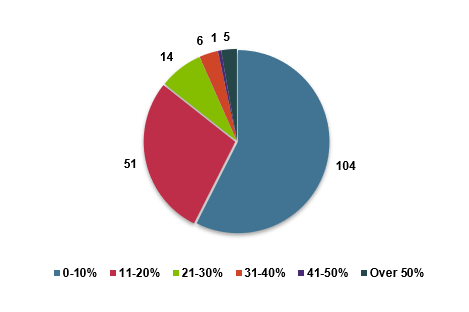
From Figure 5, it is evident that at the majority of SEMS holdings where data was available, the recorded percentage lamb loss in the marking-weaning period in 2024 was in the 0-10% category.
At SEMS holdings receiving standard measures support in 2024, the average percentage lamb loss in the marking-weaning period was 13.1%. Holdings receiving enhanced measures support, excluding enhanced shepherding, had an average percentage lamb loss of 8.7% in the marking-weaning period in 2024. Holdings receiving support for enhanced shepherding in 2024 had an average percentage lamb loss of 8.2% in the marking-weaning period.
Figure 6 below compares average, high and low percentage lamb loss figures in the marking-weaning period at SEMS holdings between 2016 and 2024.
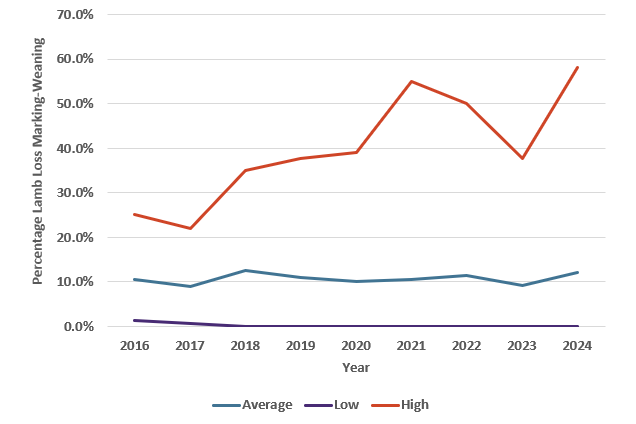
From Figure 6 it is evident that the average percentage lamb loss recorded at SEMS holdings increased in 2024 to 12.1% from 9.2% in 2023. The average recorded in 2024 is also the highest average percentage lamb loss recorded in this period since 2018.
Whilst the low percentage lamb loss figure recorded in the marking-weaning period at SEMS holdings has remained fairly stable, the highest percentage lamb loss figure recorded at SEMS holdings in the marking-weaning period has not, with the highest percentage in the 2016-2024 period recorded in 2024.
Weaning percentage
Weaning percentage is an important performance benchmark and is calculated by dividing the number of lambs weaned by the number of ewes run with tups and multiplying this value by one hundred.
In a hefted hill flock, weaning percentage is especially important, as these flocks rely on recruitment of ewe lambs from within the flock as replacements, to ensure a healthy flock age structure and long-term sustainability of this management system.
Decreases in overall weaning percentage and associated ewe lamb numbers can have a significant impact on the flock and the business, as for those farmers and crofters managing Region 3 ground, the number of retained ewe lambs influences the level of support from the Scottish Upland Sheep Support Scheme (SUSSS).
In 2024, the average weaning percentage of SEMS holdings was 79.4%, with a range of 23.9% to 168.8%. Figure 7 below provides an overview of weaning percentages achieved at SEMS holdings in 2024 by weaning percentage category:
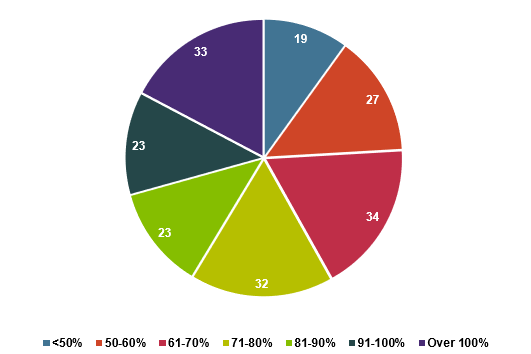
Figure 7 highlights the spread of SEMS holdings between weaning percentage categories in 2024. Unlike percentage lamb loss in the marking-weaning period, there is not one category that the majority of holdings fall under.
In 2024, holdings receiving standard measures support from the SEMS achieved an average weaning percentage of 77.7%. Holdings receiving enhanced measures support, excluding the enhanced shepherding measure achieved an average weaning percentage of 87.4%. Holdings delivering the enhanced shepherding measure in 2024 had an average weaning percentage of 80%.
Figure 8 below provides an overview of the average, high and low weaning percentages recorded at SEMS holdings in individual years in the period 2016-2024:
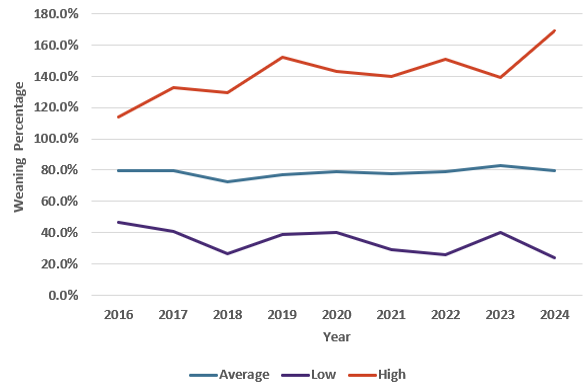
From figure 8, it is evident that there has been a slight decline in the average weaning percentage at SEMS holdings between 2023 and 2024, but the average figure has remained relatively stable. It is also evident from figure 8 that 2024 seen the highest weaning percentage in the 2016-2024 period recorded but also the lowest weaning percentage figure in this period recorded.
Concluding remarks
WTE predation of livestock is a complex issue and the lambing performance data from SEMS holdings detailed in this report highlights the wide-ranging nature of performance across SEMS holdings.
This is reflective of the differing management systems at SEMS holdings, the nature of issues with predation and other factors influencing loss and the scale of these impacts.
This data highlights the importance of the case-by-case approach that the SEMS adopts in attempts to better understand and mitigate predation impacts.
The views and feedback of some farmers and crofters experiencing WTE predation and participating in the SEMS have been collated in the spreadsheet that accompanies this report.
It is clear from the collated feedback that there are mixed views on the effectiveness of the SEMS in mitigating issues and the appropriateness of the support levels in reflecting the costs of living and working alongside WTE. The SEMS is currently under review for 2025 and this feedback along with stakeholder representative’s feedback at review workshops will help inform discussions about the SEMS format in 2025.
NatureScot recognises the concern and seriousness of this issue to some farmers and crofters across parts of Scotland and continues to work closely with stakeholders at a local and national level to find solutions.
Acknowledgements
NatureScot acknowledges and thanks the farmers and crofters who liaised closely with SEMS staff and contractors in 2024 and provided data and feedback to inform this report and wider work.
NatureScot acknowledges the ongoing collaborative work with stakeholders represented on the National Sea Eagle Stakeholder Panel and Local Sea Eagle Stakeholder Groups in 2024 on this issue.
NatureScot acknowledges the vital role of the call off contractor and observer team in 2024, in providing expert advice and assistance in the delivery of the SEMS, including associated monitoring and liaison work. Thanks also go to Scottish Raptor Study Group, FLS and RSPB Scotland who have provided data and assistance with fieldwork delivered in 2024.
